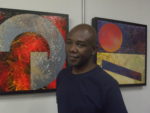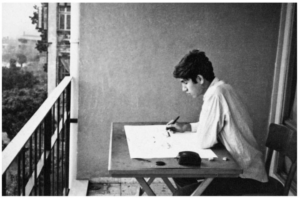
Don Mattera, a poetry icon of Eldorado Park, Johannesburg, passed away on 18 July 2022. Moving tributes have been penned in his honour by notable South African academic, Jonathan Jansen, journalist, Ismail Lagardien and a friend and collaborator of the late poet, J. Brooks Spector. Spector’s article, perhaps, most evocatively captures Mattera’s mercurial creativity and poetic essence. Even under apartheid oppression, he was an unforgettable presence who never failed to assert himself unequivocally. In bleak times that ordinarily should have crushed individual spontaneity and imagination, Mattera somehow managed to thrive and inspire those around him, most especially the youth. He mingled effortlessly with the urban downtrodden and walked tall amongst society’s cultural elites. Accomplishing all of this with an adaptability that was naturally effortless, testifying to the range and richness of his personality.
Born in 1935, Mattera’s antecedents reflect South Africa’s complex social and political history, apartheid-era absurdity, and the unexpected twists within the country’s supposedly immutable identity politics. Mattera had Italian blood flowing in his veins and he was also marked by an indelible Xhosa lineage. During apartheid, his family was classified as coloured and he grew up amid a feral colony of gangsters within the cosmopolitan ambience of Sophiatown, the legendary racial and cultural melting pot demolished by the system’s racialized spatial ideology in 1955.
Mattera lived his life through a series of transformational changes and social upheavals. Imagine being of mixed race in a gangster-infested township that was nonetheless lavishly enlivened with raucous spots of culture, flamboyant colour, and the magic of joie de vivre. Undoubtedly, Sophiatown was also a cherished artist’s haven. It was full of larger-than-life characters, must-see taverns, and sartorial splendour that would send you into whirlpools of nostalgia and pathos.
Mattera was a composite of stirring elemental attributes and psychological profiles. Not many could undergo a strict Catholic education yet become a practising Muslim. Fewer still could have been a seemingly irredeemable gangster, who joined and later led the Vultures gang, to then become an inspirational poet. Catholicism and Islam, gangster and poet, man-of-action and thinker, indeed Mattera was a true product of Sophiatown’s eclectic racial and cultural potpourri. Writers, jazz artists, gangsters, and poets populated Mattera’s beloved Sophiatown. It is certain that each and every one of these distinct identities was firmly imprinted on his psyche. And each and every one of them is a mirror of life’s multivalent prism. It is no wonder that the unimaginative apartheid spatial planners had to destroy the township as part of a bid to enforce a preposterous as well as the illogical notion of racial and cultural purity. Think of Chinua Achebe’s masquerade which can only be fully appreciated from a multiplicity of optic angles.
Arguably, only Sophiatown could have produced the racial and cultural figure that was Mattera. He was in fact an amalgam of human possibilities encompassing both good and evil, incredible transformation and redemption. He was the best advocate for the adage and possibly also, cliché “everything is possible”. John W. Fredricks, who passed in 2019, was another Cape Town gangster and ex-convict who reinvented himself as the successful author of Noem My Skollie, a coming-of-age memoir and multiple award-winning movie.
The history and phenomenon of gangsterism in South Africa, as elsewhere, are quite intriguing. The unstinting element of deadly risk, death-defying ventures, easy money casually squandered, beautiful girls, copious liquor, incarceration, and sudden death seem hard to resist, sometimes. The gangster appears as the ultimate anti-social figurehead, haunting the frayed edges of community, confined to the margins of society, and yet continually transgressing them in unexpected fits of rebellion and incalculable violence. In short, the type of menace from which society needs to be defended. Mattera was once this dreaded figure, but he was able to transcend those narrow and seemingly inevitable parameters through extraordinary feats of personal reinvention.
From being an incorrigible menace to society, he became a defender of public good and wholesome solidarity. He repudiated the knife-wielding Socratic role of a corrupter of public morality and youth to become a redeemer of young and befuddled members of a fumbling generation. Such a difficult transformation is quite rare but nonetheless supports the view that a radical and positive change in outlook is always possible. It is for all of these reasons that it is such a marvel to observe the inclines and peaks in Mattera’s life.
Recently, I watched the movie Drum starring Taye Diggs and South African musician and actor, Bonginkosi Dlamini aka Zola 7. Largely set in Sophiatown, the movie is a smoky portrayal of ghetto-spawned foreboding, malice, danger, and precarious delights. Fedoras, plush gabardine suits, whiskey and cigarettes, all bathed in the irresistible allure of mercurial youth, it is obvious that such an admixture of illicitness, semi-secrecy and promise can produce exceptional beings like Mattera. However, with the death of Mattera, the Sophiatown era of writers is now effectively over. Apart from the core group comprising the Drum Magazine collective, many writers experienced the spell of Sophiatown in varying degrees including its nominal leader, Can Themba, an immensely gifted short story writer, Lewis Nkosi, an internationally acclaimed novelist, Es’kia Mphahlele, distinguished academic, and Keorapetse Willie Kgositsile, an influential poet.
Inarguably, one of the major tasks that face the former inhabitants of Sophiatown is the protracted struggles against the scourge of forgetting which is a preoccupation of Mattera’s book, Memory is the Weapon. Many of them made it their life-long mission to safeguard varied archives. In quaint photographs, songs, and gossamer-like memories, Sophiatown lives and a central part of Mattera’s life entailed serving as a filter for textual and oral anecdotes that flitted out of the famed township. Many of those who treasure those priceless memories allude to the preposterousness of apartheid ideology. People of different backgrounds, cultures, and races came together to build lives in unity, loving, fighting, crying, and surviving with all their might and powers of imagination. Despite the obvious sociopolitical constraints, nothing could be more deeply human and courageous.
There are unforgettable places with innumerable encoded memories, such as Sophiatown. There are also essential people, such as Mattera. When we lose both it then becomes our sacred duty to wage mortal combat against the virus of forgetting. A win for such a virus is fundamentally a diminution of our common humanity.
To envision the apartheid superstructure is to see it as grey, drab, and unforgiving, the official canopy that shrouds and stifles everything underneath its implacable imprimatur. Still, underneath it and lurking at its proscribed corners are carnivalesque bursts of neon lights and ghetto-bred flares of revolt. Life and death are simply two sides of the same coin. They can alternatively be serious and gloomy or light and airy. Choose your pick, your destiny is in the stars. We mourn when our dear ones die. But we also celebrate moments of terminal transition. It depends on how you view life and how you derive your thrills and heartaches. The magnificent pendulum swings of Mattera’s life aptly describe these bitter-sweet moments and movements.
In an era of live-fast-and-die-young, many mishaps, tragedies, and deaths would have broken innumerable hearts. And yet Mattera was able to live till the ripe old age of 86. At this stage, it is difficult to resist yet another cliché: “they don’t make them like that anymore”. But how could they when all possibilities are being denied us? It is no longer cool to embrace danger and existential adventure. There are brochures and manuals for everything from how to live life and survive in the wild, to how to die. There is a regimen of clinical precision at play which negates spontaneity and initiative. Figures such as Mattera were creatures of new and mysterious frontiers, intrepid denizens of zones of antimony, and pioneers who risked blood, limb, and life to experience the infinite multiplicity of existence. The miracle is that he managed not to become a desiccated stone and lived to tell the tale in his inimitable and eloquent way. He leaves behind a rich legacy of books, poetry, inspirational reflections, and good deeds.










COMMENTS -
Reader Interactions